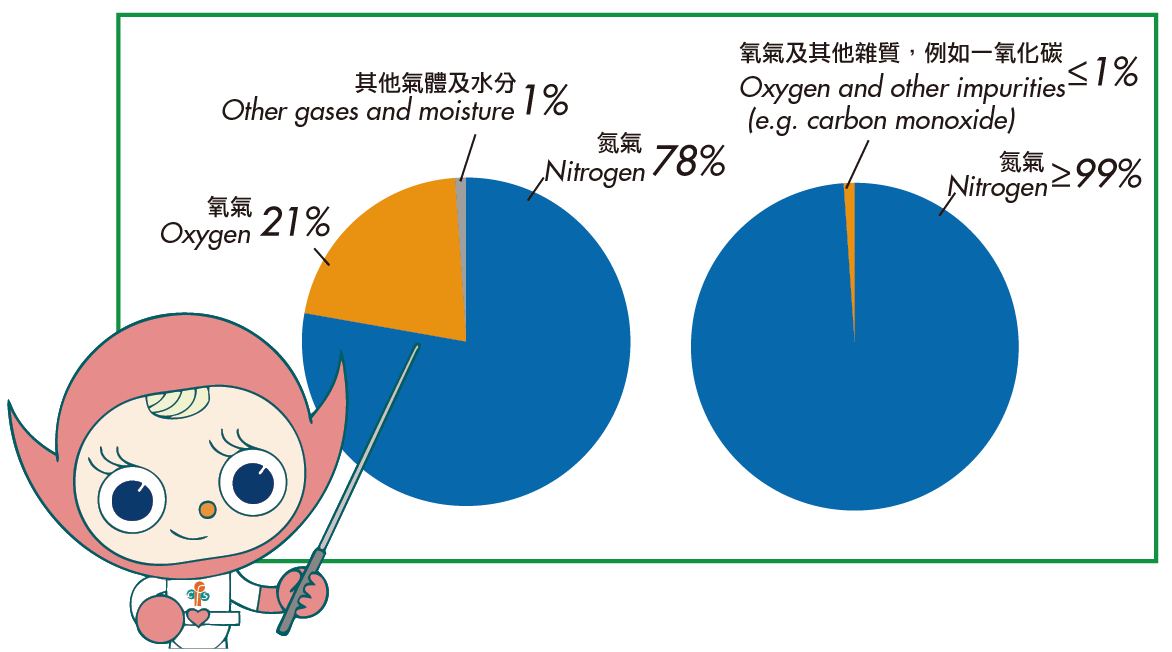
Food Safety Focus (177th Issue, April 2021) – Food Safety Platform
Nitrogen – A Packaging Gas and Beyond
Reported by Ms. Sosanna WONG, Scientific Officer,
Risk Assessment Section, Centre for Food Safety
Have you ever wondered why bags of potato chips or shrimp crackers are always inflated? Besides, why do the potato chips inside get softened and, occasionally, rancid quickly once the package is opened, even before the best-before date? Packaging gas can be considered a food additive with its unique functions in food processing to slow down food deterioration and improve longevity effectively. This article will look into the application of packaging gas in foods, the science behind and its safety.

Figure 2: Gas-filled bags of foods
What is a Packaging Gas?
Air contains approximately 78% nitrogen, 21% oxygen and a variable amount of moisture. When exposed to air, foods such as potato chips absorb moisture and go stale and soggy quickly. Atmospheric oxygen also reacts with the unsaturated fatty acids present in foods, resulting in rancid off-flavours. Consequently, it is always a challenge faced by food manufacturers in preserving the desirable quality and prolonging the shelf life of food products.
The use of packaging gas is an effective solution. A packaging gas is a gas that is introduced into a package before, during or after filling with food to protect the food from oxidation or spoilage. Examples include nitrogen, carbon dioxide and nitrous oxide. Nitrogen has a long history of use as a packaging gas in various foods including snacks, breakfast cereals, candies, bakery products, dried fruits and vegetables, and processed meat products.
Nitrogen Does More than a Packaging Gas
Nitrogen has found its way to the brewery and coffee industries where nitrogen is infused in beer or cold brew coffee to make ‘nitro beer’ or ‘nitro brew‘, giving the final product a richer and creamier mouthfeel.
How does Nitrogen Work as a Packaging Gas?
Unlike the air you breathe every second, nitrogen used in food packaging contains very little oxygen and moisture. Nitrogen is inert (i.e. not reacting with any food components), odourless and tasteless. When nitrogen is introduced into a package, it drives out oxygen and any moisture present. By modifying the atmosphere inside the package, food packaging with nitrogen preserves quality, slows down spoilage and extends the products' shelf life.
Nitrogen also cushions and protects delicate foods inside the package from being crushed during handling. Nonetheless, the amount of nitrogen used should provide enough protection but not too much to allow space for additional expansion due to pressure changes in transit and during storage.
The package, with low gas permeability, must be sealed tightly to prevent the nitrogen from escaping. Once you open the package, the food inside is exposed to atmospheric air containing oxygen and moisture. Without protection from an immediate, controlled environment, the contents are then prone to moisture pickup, spoilage and oxidation. Therefore, it is best to consume the food products as soon as possible once the package is opened.

Figure 3: Comparative composition of atmospheric air (left) and food-grade nitrogen (right)
Is Nitrogen Safe for Food Use?
Like other food additives, nitrogen has gone through rigorous safety assessment before it is ascertained as safe for food use. The Joint Food and Agriculture Organization / World Health Organization Expert Committee on Food Additives (JECFA) has evaluated the safety of food-grade nitrogen and considered that it is safe upon normal consumption when used in foods following Good Manufacturing Practice.
What is Food-grade Nitrogen?
Food-grade nitrogen has a high concentration of nitrogen (i.e. not less than 99%). In contrast, non-food-grade nitrogen may not achieve the intended functions and may contain impurities, and is therefore not suitable for food use. As stipulated in the Public Health and Municipal Services Ordinance (Cap. 132), all foods for sale in Hong Kong must be fit for human consumption. Only food-grade nitrogen with high purity should be used for food applications to ensure food safety and preserve food quality.


